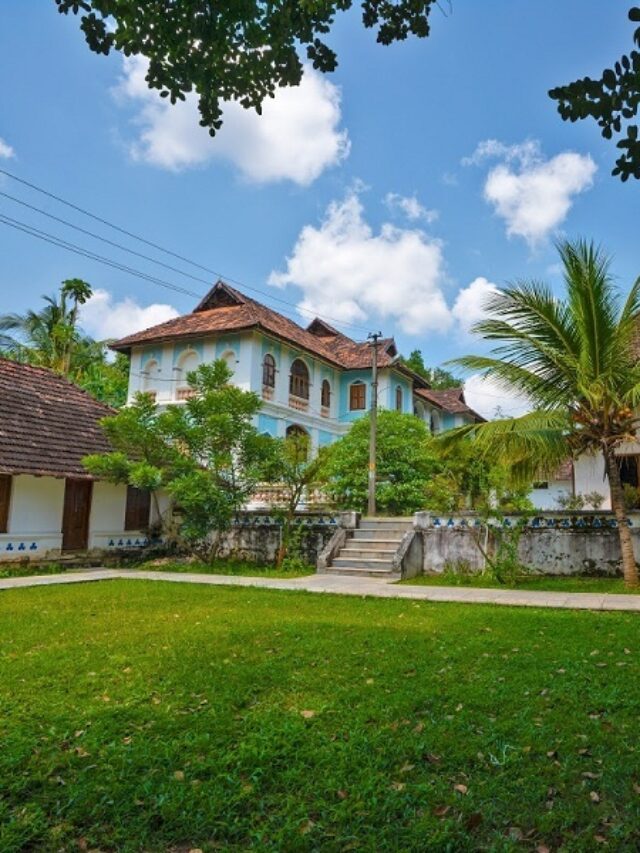Kerala is a coastal southern state of the Indian subcontinent. Not only is it famous for its numerous beaches, and art festival Kochi-Muziris Biennale, but also for birthing numerous painters. One of them is Raja Ravi Varma. Nestled amidst the lush greenery of Kerala, the Kilimanoor Palace stands as a testament to the rich cultural heritage and architectural marvels of the region. Located in the quaint village of Kilimanoor in Kerala, India, this palace is not just a mere structure but a treasure trove of history, art, and architecture that beckons travellers and art enthusiasts from around the globe.
A History of Kilimanoor Palace Kilimanoor Kerala
The history of Kilimanoor Palace dates back to the 18th century when it served as the residence of the illustrious rulers of the Kilimanoor princely state. The palace holds a significant place in Kerala’s history, being the birthplace of Raja Ravi Varma, one of India’s most renowned painters. It was under the patronage of the Kilimanoor rulers that Raja Ravi Varma honed his artistic skills, ultimately becoming a pioneer of Indian art. He revolutionized Indian art with his exquisite paintings that captured the essence of Indian mythology and culture. His mastery of technique and profound storytelling through art earned him recognition not only in India but also on the global stage.

The palace also housed other members of the Kilimanoor royal family who were patrons of art and culture, further enriching its cultural heritage. Their contributions to the preservation and promotion of traditional Kerala art forms are immeasurable, making Kilimanoor Palace a sanctuary of artistic expression and creativity.
Artistic Treasures At Kilimanoor Palace Kilimanoor Kerala
One of the most bewitching aspects of Kilimanoor Palace is its impressive collection of paintings, many of which are attributed to Raja Ravi Varma himself. These paintings, characterized by their vibrant colours, intricate details, and emotive storytelling, offer a glimpse into the rich tapestry of Indian mythology and history. Among the notable works housed within the palace is Raja Ravi Varma‘s iconic painting ‘Shakuntala,’ which depicts a poignant moment from the epic Mahabharata. The palace also boasts an array of portraits, landscapes, and mythological scenes, each showcasing the artist’s unparalleled talent and vision.

In addition to Raja Ravi Varma’s masterpieces, Kilimanoor Palace is home to a diverse collection of artworks spanning various genres and styles. From traditional Kerala murals to contemporary sculptures, the Palace Museum offers a comprehensive exploration of Kerala’s artistic heritage.
Architectural Splendor of Kilimanoor Palace Kilimanoor Kerala
Beyond its artistic treasures, Kilimanoor Palace mesmerizes visitors with its exquisite architecture that reflects the grandeur of Kerala’s royal past. The palace complex is a harmonious blend of traditional Kerala and colonial architectural styles, featuring intricately carved wooden pillars, ornate doorways, and sprawling courtyards. Made over 15 acres of land, it is a traditional Kerala residential space, fit with groves, small & medium-sized buildings, wells, and ponds. The palace’s distinctive sloping roofs, known as ‘nalukettu’, are a hallmark of traditional Kerala architecture, designed to withstand the region’s tropical climate.
When the king of Travancore, Marthanda Varma granted autonomy to Kilimanoor, the palace was built to its current state in 1753. Enclosed within the 300-year-old palace are several small shrines or ‘kavus’ serving as worship spaces for the family members. The main entrance is a stone archway that opens to an enormous courtyard. As soon as one enters through the main entrance, they are presented with Varma’s studio where he painted his genius. The museum housed within the palace complex takes the visitor on a journey through Kerala’s architectural evolution, showcasing models, artefacts, and exhibits that highlight the region’s rich architectural heritage.

To the right of Varma’s studio stands ‘Puthenmalika’ which is said to be designed, and funded by Varma himself. It is said that he wished to convert it into an art gallery. The Kilimanoor Palace Museum also exhibits Varma’s reprinted works. From ancient temples to colonial mansions, the museum provides valuable insights into Kerala’s architectural legacy, making it a must-visit destination for art and architecture enthusiasts.
Whether you’re an art aficionado, a history buff, or simply a traveller seeking to immerse yourself in Kerala’s vibrant culture, Kilimanoor Palace offers a truly enchanting experience that transcends time and space. As you wander through its hallowed halls and marvel at its artistic wonders, you’ll find yourself transported to the opulent lifestyle of the royal Travancore family (some of whom still live within the premises).
Image Courtesy – Trawell
Preserving A Timeless Culture: Revi Karunakaran Memorial Museum






